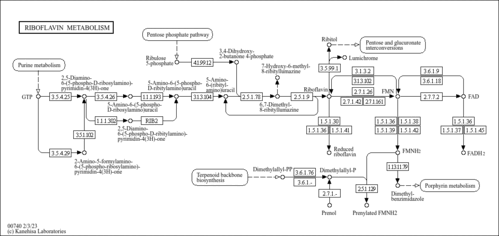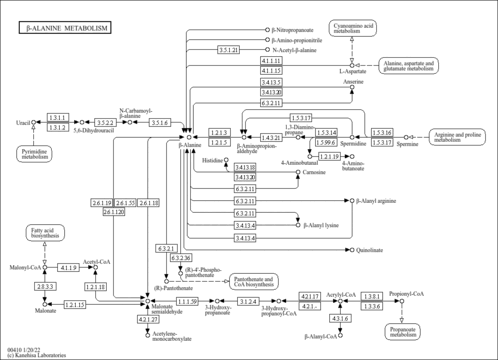| Flavin mononucleotide,1TMS,isomer #1 | CC1=CC2=C(C=C1C)N(C[C@H](O[Si](C)(C)C)[C@H](O)[C@H](O)COP(=O)(O)O)C1=NC(=O)[NH]C(=O)C1=N2 | 3652.0 | Semi standard non polar | 33892256 |
| Flavin mononucleotide,1TMS,isomer #2 | CC1=CC2=C(C=C1C)N(C[C@H](O)[C@H](O[Si](C)(C)C)[C@H](O)COP(=O)(O)O)C1=NC(=O)[NH]C(=O)C1=N2 | 3648.1 | Semi standard non polar | 33892256 |
| Flavin mononucleotide,1TMS,isomer #3 | CC1=CC2=C(C=C1C)N(C[C@H](O)[C@H](O)[C@@H](COP(=O)(O)O)O[Si](C)(C)C)C1=NC(=O)[NH]C(=O)C1=N2 | 3682.6 | Semi standard non polar | 33892256 |
| Flavin mononucleotide,1TMS,isomer #4 | CC1=CC2=C(C=C1C)N(C[C@H](O)[C@H](O)[C@H](O)COP(=O)(O)O[Si](C)(C)C)C1=NC(=O)[NH]C(=O)C1=N2 | 3846.1 | Semi standard non polar | 33892256 |
| Flavin mononucleotide,1TMS,isomer #5 | CC1=CC2=C(C=C1C)N(C[C@H](O)[C@H](O)[C@H](O)COP(=O)(O)O)C1=NC(=O)N([Si](C)(C)C)C(=O)C1=N2 | 3803.7 | Semi standard non polar | 33892256 |
| Flavin mononucleotide,2TMS,isomer #1 | CC1=CC2=C(C=C1C)N(C[C@H](O[Si](C)(C)C)[C@H](O[Si](C)(C)C)[C@H](O)COP(=O)(O)O)C1=NC(=O)[NH]C(=O)C1=N2 | 3550.4 | Semi standard non polar | 33892256 |
| Flavin mononucleotide,2TMS,isomer #10 | CC1=CC2=C(C=C1C)N(C[C@H](O)[C@H](O)[C@H](O)COP(=O)(O[Si](C)(C)C)O[Si](C)(C)C)C1=NC(=O)[NH]C(=O)C1=N2 | 3779.3 | Semi standard non polar | 33892256 |
| Flavin mononucleotide,2TMS,isomer #11 | CC1=CC2=C(C=C1C)N(C[C@H](O)[C@H](O)[C@H](O)COP(=O)(O)O[Si](C)(C)C)C1=NC(=O)N([Si](C)(C)C)C(=O)C1=N2 | 3848.5 | Semi standard non polar | 33892256 |
| Flavin mononucleotide,2TMS,isomer #2 | CC1=CC2=C(C=C1C)N(C[C@H](O[Si](C)(C)C)[C@H](O)[C@@H](COP(=O)(O)O)O[Si](C)(C)C)C1=NC(=O)[NH]C(=O)C1=N2 | 3572.5 | Semi standard non polar | 33892256 |
| Flavin mononucleotide,2TMS,isomer #3 | CC1=CC2=C(C=C1C)N(C[C@H](O[Si](C)(C)C)[C@H](O)[C@H](O)COP(=O)(O)O[Si](C)(C)C)C1=NC(=O)[NH]C(=O)C1=N2 | 3682.7 | Semi standard non polar | 33892256 |
| Flavin mononucleotide,2TMS,isomer #4 | CC1=CC2=C(C=C1C)N(C[C@H](O[Si](C)(C)C)[C@H](O)[C@H](O)COP(=O)(O)O)C1=NC(=O)N([Si](C)(C)C)C(=O)C1=N2 | 3673.3 | Semi standard non polar | 33892256 |
| Flavin mononucleotide,2TMS,isomer #5 | CC1=CC2=C(C=C1C)N(C[C@H](O)[C@H](O[Si](C)(C)C)[C@@H](COP(=O)(O)O)O[Si](C)(C)C)C1=NC(=O)[NH]C(=O)C1=N2 | 3567.2 | Semi standard non polar | 33892256 |
| Flavin mononucleotide,2TMS,isomer #6 | CC1=CC2=C(C=C1C)N(C[C@H](O)[C@H](O[Si](C)(C)C)[C@H](O)COP(=O)(O)O[Si](C)(C)C)C1=NC(=O)[NH]C(=O)C1=N2 | 3659.2 | Semi standard non polar | 33892256 |
| Flavin mononucleotide,2TMS,isomer #7 | CC1=CC2=C(C=C1C)N(C[C@H](O)[C@H](O[Si](C)(C)C)[C@H](O)COP(=O)(O)O)C1=NC(=O)N([Si](C)(C)C)C(=O)C1=N2 | 3660.2 | Semi standard non polar | 33892256 |
| Flavin mononucleotide,2TMS,isomer #8 | CC1=CC2=C(C=C1C)N(C[C@H](O)[C@H](O)[C@@H](COP(=O)(O)O[Si](C)(C)C)O[Si](C)(C)C)C1=NC(=O)[NH]C(=O)C1=N2 | 3705.2 | Semi standard non polar | 33892256 |
| Flavin mononucleotide,2TMS,isomer #9 | CC1=CC2=C(C=C1C)N(C[C@H](O)[C@H](O)[C@@H](COP(=O)(O)O)O[Si](C)(C)C)C1=NC(=O)N([Si](C)(C)C)C(=O)C1=N2 | 3691.9 | Semi standard non polar | 33892256 |
| Flavin mononucleotide,3TMS,isomer #1 | CC1=CC2=C(C=C1C)N(C[C@H](O[Si](C)(C)C)[C@H](O[Si](C)(C)C)[C@@H](COP(=O)(O)O)O[Si](C)(C)C)C1=NC(=O)[NH]C(=O)C1=N2 | 3537.5 | Semi standard non polar | 33892256 |
| Flavin mononucleotide,3TMS,isomer #10 | CC1=CC2=C(C=C1C)N(C[C@H](O)[C@H](O[Si](C)(C)C)[C@H](O)COP(=O)(O[Si](C)(C)C)O[Si](C)(C)C)C1=NC(=O)[NH]C(=O)C1=N2 | 3638.0 | Semi standard non polar | 33892256 |
| Flavin mononucleotide,3TMS,isomer #11 | CC1=CC2=C(C=C1C)N(C[C@H](O)[C@H](O[Si](C)(C)C)[C@H](O)COP(=O)(O)O[Si](C)(C)C)C1=NC(=O)N([Si](C)(C)C)C(=O)C1=N2 | 3697.8 | Semi standard non polar | 33892256 |
| Flavin mononucleotide,3TMS,isomer #12 | CC1=CC2=C(C=C1C)N(C[C@H](O)[C@H](O)[C@@H](COP(=O)(O[Si](C)(C)C)O[Si](C)(C)C)O[Si](C)(C)C)C1=NC(=O)[NH]C(=O)C1=N2 | 3680.4 | Semi standard non polar | 33892256 |
| Flavin mononucleotide,3TMS,isomer #13 | CC1=CC2=C(C=C1C)N(C[C@H](O)[C@H](O)[C@@H](COP(=O)(O)O[Si](C)(C)C)O[Si](C)(C)C)C1=NC(=O)N([Si](C)(C)C)C(=O)C1=N2 | 3733.8 | Semi standard non polar | 33892256 |
| Flavin mononucleotide,3TMS,isomer #14 | CC1=CC2=C(C=C1C)N(C[C@H](O)[C@H](O)[C@H](O)COP(=O)(O[Si](C)(C)C)O[Si](C)(C)C)C1=NC(=O)N([Si](C)(C)C)C(=O)C1=N2 | 3798.6 | Semi standard non polar | 33892256 |
| Flavin mononucleotide,3TMS,isomer #2 | CC1=CC2=C(C=C1C)N(C[C@H](O[Si](C)(C)C)[C@H](O[Si](C)(C)C)[C@H](O)COP(=O)(O)O[Si](C)(C)C)C1=NC(=O)[NH]C(=O)C1=N2 | 3598.2 | Semi standard non polar | 33892256 |
| Flavin mononucleotide,3TMS,isomer #3 | CC1=CC2=C(C=C1C)N(C[C@H](O[Si](C)(C)C)[C@H](O[Si](C)(C)C)[C@H](O)COP(=O)(O)O)C1=NC(=O)N([Si](C)(C)C)C(=O)C1=N2 | 3615.6 | Semi standard non polar | 33892256 |
| Flavin mononucleotide,3TMS,isomer #4 | CC1=CC2=C(C=C1C)N(C[C@H](O[Si](C)(C)C)[C@H](O)[C@@H](COP(=O)(O)O[Si](C)(C)C)O[Si](C)(C)C)C1=NC(=O)[NH]C(=O)C1=N2 | 3613.1 | Semi standard non polar | 33892256 |
| Flavin mononucleotide,3TMS,isomer #5 | CC1=CC2=C(C=C1C)N(C[C@H](O[Si](C)(C)C)[C@H](O)[C@@H](COP(=O)(O)O)O[Si](C)(C)C)C1=NC(=O)N([Si](C)(C)C)C(=O)C1=N2 | 3626.2 | Semi standard non polar | 33892256 |
| Flavin mononucleotide,3TMS,isomer #6 | CC1=CC2=C(C=C1C)N(C[C@H](O[Si](C)(C)C)[C@H](O)[C@H](O)COP(=O)(O[Si](C)(C)C)O[Si](C)(C)C)C1=NC(=O)[NH]C(=O)C1=N2 | 3664.3 | Semi standard non polar | 33892256 |
| Flavin mononucleotide,3TMS,isomer #7 | CC1=CC2=C(C=C1C)N(C[C@H](O[Si](C)(C)C)[C@H](O)[C@H](O)COP(=O)(O)O[Si](C)(C)C)C1=NC(=O)N([Si](C)(C)C)C(=O)C1=N2 | 3720.8 | Semi standard non polar | 33892256 |
| Flavin mononucleotide,3TMS,isomer #8 | CC1=CC2=C(C=C1C)N(C[C@H](O)[C@H](O[Si](C)(C)C)[C@@H](COP(=O)(O)O[Si](C)(C)C)O[Si](C)(C)C)C1=NC(=O)[NH]C(=O)C1=N2 | 3615.5 | Semi standard non polar | 33892256 |
| Flavin mononucleotide,3TMS,isomer #9 | CC1=CC2=C(C=C1C)N(C[C@H](O)[C@H](O[Si](C)(C)C)[C@@H](COP(=O)(O)O)O[Si](C)(C)C)C1=NC(=O)N([Si](C)(C)C)C(=O)C1=N2 | 3629.8 | Semi standard non polar | 33892256 |
| Flavin mononucleotide,4TMS,isomer #1 | CC1=CC2=C(C=C1C)N(C[C@H](O[Si](C)(C)C)[C@H](O[Si](C)(C)C)[C@@H](COP(=O)(O)O[Si](C)(C)C)O[Si](C)(C)C)C1=NC(=O)[NH]C(=O)C1=N2 | 3612.3 | Semi standard non polar | 33892256 |
| Flavin mononucleotide,4TMS,isomer #1 | CC1=CC2=C(C=C1C)N(C[C@H](O[Si](C)(C)C)[C@H](O[Si](C)(C)C)[C@@H](COP(=O)(O)O[Si](C)(C)C)O[Si](C)(C)C)C1=NC(=O)[NH]C(=O)C1=N2 | 3771.2 | Standard non polar | 33892256 |
| Flavin mononucleotide,4TMS,isomer #1 | CC1=CC2=C(C=C1C)N(C[C@H](O[Si](C)(C)C)[C@H](O[Si](C)(C)C)[C@@H](COP(=O)(O)O[Si](C)(C)C)O[Si](C)(C)C)C1=NC(=O)[NH]C(=O)C1=N2 | 4988.6 | Standard polar | 33892256 |
| Flavin mononucleotide,4TMS,isomer #10 | CC1=CC2=C(C=C1C)N(C[C@H](O)[C@H](O[Si](C)(C)C)[C@H](O)COP(=O)(O[Si](C)(C)C)O[Si](C)(C)C)C1=NC(=O)N([Si](C)(C)C)C(=O)C1=N2 | 3716.8 | Semi standard non polar | 33892256 |
| Flavin mononucleotide,4TMS,isomer #10 | CC1=CC2=C(C=C1C)N(C[C@H](O)[C@H](O[Si](C)(C)C)[C@H](O)COP(=O)(O[Si](C)(C)C)O[Si](C)(C)C)C1=NC(=O)N([Si](C)(C)C)C(=O)C1=N2 | 3770.5 | Standard non polar | 33892256 |
| Flavin mononucleotide,4TMS,isomer #10 | CC1=CC2=C(C=C1C)N(C[C@H](O)[C@H](O[Si](C)(C)C)[C@H](O)COP(=O)(O[Si](C)(C)C)O[Si](C)(C)C)C1=NC(=O)N([Si](C)(C)C)C(=O)C1=N2 | 4718.7 | Standard polar | 33892256 |
| Flavin mononucleotide,4TMS,isomer #11 | CC1=CC2=C(C=C1C)N(C[C@H](O)[C@H](O)[C@@H](COP(=O)(O[Si](C)(C)C)O[Si](C)(C)C)O[Si](C)(C)C)C1=NC(=O)N([Si](C)(C)C)C(=O)C1=N2 | 3744.2 | Semi standard non polar | 33892256 |
| Flavin mononucleotide,4TMS,isomer #11 | CC1=CC2=C(C=C1C)N(C[C@H](O)[C@H](O)[C@@H](COP(=O)(O[Si](C)(C)C)O[Si](C)(C)C)O[Si](C)(C)C)C1=NC(=O)N([Si](C)(C)C)C(=O)C1=N2 | 3798.7 | Standard non polar | 33892256 |
| Flavin mononucleotide,4TMS,isomer #11 | CC1=CC2=C(C=C1C)N(C[C@H](O)[C@H](O)[C@@H](COP(=O)(O[Si](C)(C)C)O[Si](C)(C)C)O[Si](C)(C)C)C1=NC(=O)N([Si](C)(C)C)C(=O)C1=N2 | 4815.2 | Standard polar | 33892256 |
| Flavin mononucleotide,4TMS,isomer #2 | CC1=CC2=C(C=C1C)N(C[C@H](O[Si](C)(C)C)[C@H](O[Si](C)(C)C)[C@@H](COP(=O)(O)O)O[Si](C)(C)C)C1=NC(=O)N([Si](C)(C)C)C(=O)C1=N2 | 3626.6 | Semi standard non polar | 33892256 |
| Flavin mononucleotide,4TMS,isomer #2 | CC1=CC2=C(C=C1C)N(C[C@H](O[Si](C)(C)C)[C@H](O[Si](C)(C)C)[C@@H](COP(=O)(O)O)O[Si](C)(C)C)C1=NC(=O)N([Si](C)(C)C)C(=O)C1=N2 | 3809.4 | Standard non polar | 33892256 |
| Flavin mononucleotide,4TMS,isomer #2 | CC1=CC2=C(C=C1C)N(C[C@H](O[Si](C)(C)C)[C@H](O[Si](C)(C)C)[C@@H](COP(=O)(O)O)O[Si](C)(C)C)C1=NC(=O)N([Si](C)(C)C)C(=O)C1=N2 | 5305.3 | Standard polar | 33892256 |
| Flavin mononucleotide,4TMS,isomer #3 | CC1=CC2=C(C=C1C)N(C[C@H](O[Si](C)(C)C)[C@H](O[Si](C)(C)C)[C@H](O)COP(=O)(O[Si](C)(C)C)O[Si](C)(C)C)C1=NC(=O)[NH]C(=O)C1=N2 | 3619.6 | Semi standard non polar | 33892256 |
| Flavin mononucleotide,4TMS,isomer #3 | CC1=CC2=C(C=C1C)N(C[C@H](O[Si](C)(C)C)[C@H](O[Si](C)(C)C)[C@H](O)COP(=O)(O[Si](C)(C)C)O[Si](C)(C)C)C1=NC(=O)[NH]C(=O)C1=N2 | 3777.5 | Standard non polar | 33892256 |
| Flavin mononucleotide,4TMS,isomer #3 | CC1=CC2=C(C=C1C)N(C[C@H](O[Si](C)(C)C)[C@H](O[Si](C)(C)C)[C@H](O)COP(=O)(O[Si](C)(C)C)O[Si](C)(C)C)C1=NC(=O)[NH]C(=O)C1=N2 | 4715.4 | Standard polar | 33892256 |
| Flavin mononucleotide,4TMS,isomer #4 | CC1=CC2=C(C=C1C)N(C[C@H](O[Si](C)(C)C)[C@H](O[Si](C)(C)C)[C@H](O)COP(=O)(O)O[Si](C)(C)C)C1=NC(=O)N([Si](C)(C)C)C(=O)C1=N2 | 3672.0 | Semi standard non polar | 33892256 |
| Flavin mononucleotide,4TMS,isomer #4 | CC1=CC2=C(C=C1C)N(C[C@H](O[Si](C)(C)C)[C@H](O[Si](C)(C)C)[C@H](O)COP(=O)(O)O[Si](C)(C)C)C1=NC(=O)N([Si](C)(C)C)C(=O)C1=N2 | 3771.6 | Standard non polar | 33892256 |
| Flavin mononucleotide,4TMS,isomer #4 | CC1=CC2=C(C=C1C)N(C[C@H](O[Si](C)(C)C)[C@H](O[Si](C)(C)C)[C@H](O)COP(=O)(O)O[Si](C)(C)C)C1=NC(=O)N([Si](C)(C)C)C(=O)C1=N2 | 4989.5 | Standard polar | 33892256 |
| Flavin mononucleotide,4TMS,isomer #5 | CC1=CC2=C(C=C1C)N(C[C@H](O[Si](C)(C)C)[C@H](O)[C@@H](COP(=O)(O[Si](C)(C)C)O[Si](C)(C)C)O[Si](C)(C)C)C1=NC(=O)[NH]C(=O)C1=N2 | 3629.0 | Semi standard non polar | 33892256 |
| Flavin mononucleotide,4TMS,isomer #5 | CC1=CC2=C(C=C1C)N(C[C@H](O[Si](C)(C)C)[C@H](O)[C@@H](COP(=O)(O[Si](C)(C)C)O[Si](C)(C)C)O[Si](C)(C)C)C1=NC(=O)[NH]C(=O)C1=N2 | 3793.3 | Standard non polar | 33892256 |
| Flavin mononucleotide,4TMS,isomer #5 | CC1=CC2=C(C=C1C)N(C[C@H](O[Si](C)(C)C)[C@H](O)[C@@H](COP(=O)(O[Si](C)(C)C)O[Si](C)(C)C)O[Si](C)(C)C)C1=NC(=O)[NH]C(=O)C1=N2 | 4759.5 | Standard polar | 33892256 |
| Flavin mononucleotide,4TMS,isomer #6 | CC1=CC2=C(C=C1C)N(C[C@H](O[Si](C)(C)C)[C@H](O)[C@@H](COP(=O)(O)O[Si](C)(C)C)O[Si](C)(C)C)C1=NC(=O)N([Si](C)(C)C)C(=O)C1=N2 | 3688.6 | Semi standard non polar | 33892256 |
| Flavin mononucleotide,4TMS,isomer #6 | CC1=CC2=C(C=C1C)N(C[C@H](O[Si](C)(C)C)[C@H](O)[C@@H](COP(=O)(O)O[Si](C)(C)C)O[Si](C)(C)C)C1=NC(=O)N([Si](C)(C)C)C(=O)C1=N2 | 3786.5 | Standard non polar | 33892256 |
| Flavin mononucleotide,4TMS,isomer #6 | CC1=CC2=C(C=C1C)N(C[C@H](O[Si](C)(C)C)[C@H](O)[C@@H](COP(=O)(O)O[Si](C)(C)C)O[Si](C)(C)C)C1=NC(=O)N([Si](C)(C)C)C(=O)C1=N2 | 5037.1 | Standard polar | 33892256 |
| Flavin mononucleotide,4TMS,isomer #7 | CC1=CC2=C(C=C1C)N(C[C@H](O[Si](C)(C)C)[C@H](O)[C@H](O)COP(=O)(O[Si](C)(C)C)O[Si](C)(C)C)C1=NC(=O)N([Si](C)(C)C)C(=O)C1=N2 | 3734.0 | Semi standard non polar | 33892256 |
| Flavin mononucleotide,4TMS,isomer #7 | CC1=CC2=C(C=C1C)N(C[C@H](O[Si](C)(C)C)[C@H](O)[C@H](O)COP(=O)(O[Si](C)(C)C)O[Si](C)(C)C)C1=NC(=O)N([Si](C)(C)C)C(=O)C1=N2 | 3810.7 | Standard non polar | 33892256 |
| Flavin mononucleotide,4TMS,isomer #7 | CC1=CC2=C(C=C1C)N(C[C@H](O[Si](C)(C)C)[C@H](O)[C@H](O)COP(=O)(O[Si](C)(C)C)O[Si](C)(C)C)C1=NC(=O)N([Si](C)(C)C)C(=O)C1=N2 | 4807.0 | Standard polar | 33892256 |
| Flavin mononucleotide,4TMS,isomer #8 | CC1=CC2=C(C=C1C)N(C[C@H](O)[C@H](O[Si](C)(C)C)[C@@H](COP(=O)(O[Si](C)(C)C)O[Si](C)(C)C)O[Si](C)(C)C)C1=NC(=O)[NH]C(=O)C1=N2 | 3642.4 | Semi standard non polar | 33892256 |
| Flavin mononucleotide,4TMS,isomer #8 | CC1=CC2=C(C=C1C)N(C[C@H](O)[C@H](O[Si](C)(C)C)[C@@H](COP(=O)(O[Si](C)(C)C)O[Si](C)(C)C)O[Si](C)(C)C)C1=NC(=O)[NH]C(=O)C1=N2 | 3772.6 | Standard non polar | 33892256 |
| Flavin mononucleotide,4TMS,isomer #8 | CC1=CC2=C(C=C1C)N(C[C@H](O)[C@H](O[Si](C)(C)C)[C@@H](COP(=O)(O[Si](C)(C)C)O[Si](C)(C)C)O[Si](C)(C)C)C1=NC(=O)[NH]C(=O)C1=N2 | 4711.4 | Standard polar | 33892256 |
| Flavin mononucleotide,4TMS,isomer #9 | CC1=CC2=C(C=C1C)N(C[C@H](O)[C@H](O[Si](C)(C)C)[C@@H](COP(=O)(O)O[Si](C)(C)C)O[Si](C)(C)C)C1=NC(=O)N([Si](C)(C)C)C(=O)C1=N2 | 3691.4 | Semi standard non polar | 33892256 |
| Flavin mononucleotide,4TMS,isomer #9 | CC1=CC2=C(C=C1C)N(C[C@H](O)[C@H](O[Si](C)(C)C)[C@@H](COP(=O)(O)O[Si](C)(C)C)O[Si](C)(C)C)C1=NC(=O)N([Si](C)(C)C)C(=O)C1=N2 | 3768.9 | Standard non polar | 33892256 |
| Flavin mononucleotide,4TMS,isomer #9 | CC1=CC2=C(C=C1C)N(C[C@H](O)[C@H](O[Si](C)(C)C)[C@@H](COP(=O)(O)O[Si](C)(C)C)O[Si](C)(C)C)C1=NC(=O)N([Si](C)(C)C)C(=O)C1=N2 | 4999.8 | Standard polar | 33892256 |
| Flavin mononucleotide,5TMS,isomer #1 | CC1=CC2=C(C=C1C)N(C[C@H](O[Si](C)(C)C)[C@H](O[Si](C)(C)C)[C@@H](COP(=O)(O[Si](C)(C)C)O[Si](C)(C)C)O[Si](C)(C)C)C1=NC(=O)[NH]C(=O)C1=N2 | 3663.2 | Semi standard non polar | 33892256 |
| Flavin mononucleotide,5TMS,isomer #1 | CC1=CC2=C(C=C1C)N(C[C@H](O[Si](C)(C)C)[C@H](O[Si](C)(C)C)[C@@H](COP(=O)(O[Si](C)(C)C)O[Si](C)(C)C)O[Si](C)(C)C)C1=NC(=O)[NH]C(=O)C1=N2 | 3679.5 | Standard non polar | 33892256 |
| Flavin mononucleotide,5TMS,isomer #1 | CC1=CC2=C(C=C1C)N(C[C@H](O[Si](C)(C)C)[C@H](O[Si](C)(C)C)[C@@H](COP(=O)(O[Si](C)(C)C)O[Si](C)(C)C)O[Si](C)(C)C)C1=NC(=O)[NH]C(=O)C1=N2 | 4520.7 | Standard polar | 33892256 |
| Flavin mononucleotide,5TMS,isomer #2 | CC1=CC2=C(C=C1C)N(C[C@H](O[Si](C)(C)C)[C@H](O[Si](C)(C)C)[C@@H](COP(=O)(O)O[Si](C)(C)C)O[Si](C)(C)C)C1=NC(=O)N([Si](C)(C)C)C(=O)C1=N2 | 3702.8 | Semi standard non polar | 33892256 |
| Flavin mononucleotide,5TMS,isomer #2 | CC1=CC2=C(C=C1C)N(C[C@H](O[Si](C)(C)C)[C@H](O[Si](C)(C)C)[C@@H](COP(=O)(O)O[Si](C)(C)C)O[Si](C)(C)C)C1=NC(=O)N([Si](C)(C)C)C(=O)C1=N2 | 3688.1 | Standard non polar | 33892256 |
| Flavin mononucleotide,5TMS,isomer #2 | CC1=CC2=C(C=C1C)N(C[C@H](O[Si](C)(C)C)[C@H](O[Si](C)(C)C)[C@@H](COP(=O)(O)O[Si](C)(C)C)O[Si](C)(C)C)C1=NC(=O)N([Si](C)(C)C)C(=O)C1=N2 | 4737.8 | Standard polar | 33892256 |
| Flavin mononucleotide,5TMS,isomer #3 | CC1=CC2=C(C=C1C)N(C[C@H](O[Si](C)(C)C)[C@H](O[Si](C)(C)C)[C@H](O)COP(=O)(O[Si](C)(C)C)O[Si](C)(C)C)C1=NC(=O)N([Si](C)(C)C)C(=O)C1=N2 | 3715.3 | Semi standard non polar | 33892256 |
| Flavin mononucleotide,5TMS,isomer #3 | CC1=CC2=C(C=C1C)N(C[C@H](O[Si](C)(C)C)[C@H](O[Si](C)(C)C)[C@H](O)COP(=O)(O[Si](C)(C)C)O[Si](C)(C)C)C1=NC(=O)N([Si](C)(C)C)C(=O)C1=N2 | 3685.9 | Standard non polar | 33892256 |
| Flavin mononucleotide,5TMS,isomer #3 | CC1=CC2=C(C=C1C)N(C[C@H](O[Si](C)(C)C)[C@H](O[Si](C)(C)C)[C@H](O)COP(=O)(O[Si](C)(C)C)O[Si](C)(C)C)C1=NC(=O)N([Si](C)(C)C)C(=O)C1=N2 | 4519.6 | Standard polar | 33892256 |
| Flavin mononucleotide,5TMS,isomer #4 | CC1=CC2=C(C=C1C)N(C[C@H](O[Si](C)(C)C)[C@H](O)[C@@H](COP(=O)(O[Si](C)(C)C)O[Si](C)(C)C)O[Si](C)(C)C)C1=NC(=O)N([Si](C)(C)C)C(=O)C1=N2 | 3725.4 | Semi standard non polar | 33892256 |
| Flavin mononucleotide,5TMS,isomer #4 | CC1=CC2=C(C=C1C)N(C[C@H](O[Si](C)(C)C)[C@H](O)[C@@H](COP(=O)(O[Si](C)(C)C)O[Si](C)(C)C)O[Si](C)(C)C)C1=NC(=O)N([Si](C)(C)C)C(=O)C1=N2 | 3705.2 | Standard non polar | 33892256 |
| Flavin mononucleotide,5TMS,isomer #4 | CC1=CC2=C(C=C1C)N(C[C@H](O[Si](C)(C)C)[C@H](O)[C@@H](COP(=O)(O[Si](C)(C)C)O[Si](C)(C)C)O[Si](C)(C)C)C1=NC(=O)N([Si](C)(C)C)C(=O)C1=N2 | 4557.8 | Standard polar | 33892256 |
| Flavin mononucleotide,5TMS,isomer #5 | CC1=CC2=C(C=C1C)N(C[C@H](O)[C@H](O[Si](C)(C)C)[C@@H](COP(=O)(O[Si](C)(C)C)O[Si](C)(C)C)O[Si](C)(C)C)C1=NC(=O)N([Si](C)(C)C)C(=O)C1=N2 | 3737.0 | Semi standard non polar | 33892256 |
| Flavin mononucleotide,5TMS,isomer #5 | CC1=CC2=C(C=C1C)N(C[C@H](O)[C@H](O[Si](C)(C)C)[C@@H](COP(=O)(O[Si](C)(C)C)O[Si](C)(C)C)O[Si](C)(C)C)C1=NC(=O)N([Si](C)(C)C)C(=O)C1=N2 | 3682.1 | Standard non polar | 33892256 |
| Flavin mononucleotide,5TMS,isomer #5 | CC1=CC2=C(C=C1C)N(C[C@H](O)[C@H](O[Si](C)(C)C)[C@@H](COP(=O)(O[Si](C)(C)C)O[Si](C)(C)C)O[Si](C)(C)C)C1=NC(=O)N([Si](C)(C)C)C(=O)C1=N2 | 4514.1 | Standard polar | 33892256 |
| Flavin mononucleotide,6TMS,isomer #1 | CC1=CC2=C(C=C1C)N(C[C@H](O[Si](C)(C)C)[C@H](O[Si](C)(C)C)[C@@H](COP(=O)(O[Si](C)(C)C)O[Si](C)(C)C)O[Si](C)(C)C)C1=NC(=O)N([Si](C)(C)C)C(=O)C1=N2 | 3768.7 | Semi standard non polar | 33892256 |
| Flavin mononucleotide,6TMS,isomer #1 | CC1=CC2=C(C=C1C)N(C[C@H](O[Si](C)(C)C)[C@H](O[Si](C)(C)C)[C@@H](COP(=O)(O[Si](C)(C)C)O[Si](C)(C)C)O[Si](C)(C)C)C1=NC(=O)N([Si](C)(C)C)C(=O)C1=N2 | 3623.8 | Standard non polar | 33892256 |
| Flavin mononucleotide,6TMS,isomer #1 | CC1=CC2=C(C=C1C)N(C[C@H](O[Si](C)(C)C)[C@H](O[Si](C)(C)C)[C@@H](COP(=O)(O[Si](C)(C)C)O[Si](C)(C)C)O[Si](C)(C)C)C1=NC(=O)N([Si](C)(C)C)C(=O)C1=N2 | 4359.0 | Standard polar | 33892256 |
| Flavin mononucleotide,1TBDMS,isomer #1 | CC1=CC2=C(C=C1C)N(C[C@H](O[Si](C)(C)C(C)(C)C)[C@H](O)[C@H](O)COP(=O)(O)O)C1=NC(=O)[NH]C(=O)C1=N2 | 3887.7 | Semi standard non polar | 33892256 |
| Flavin mononucleotide,1TBDMS,isomer #2 | CC1=CC2=C(C=C1C)N(C[C@H](O)[C@H](O[Si](C)(C)C(C)(C)C)[C@H](O)COP(=O)(O)O)C1=NC(=O)[NH]C(=O)C1=N2 | 3875.3 | Semi standard non polar | 33892256 |
| Flavin mononucleotide,1TBDMS,isomer #3 | CC1=CC2=C(C=C1C)N(C[C@H](O)[C@H](O)[C@@H](COP(=O)(O)O)O[Si](C)(C)C(C)(C)C)C1=NC(=O)[NH]C(=O)C1=N2 | 3916.3 | Semi standard non polar | 33892256 |
| Flavin mononucleotide,1TBDMS,isomer #4 | CC1=CC2=C(C=C1C)N(C[C@H](O)[C@H](O)[C@H](O)COP(=O)(O)O[Si](C)(C)C(C)(C)C)C1=NC(=O)[NH]C(=O)C1=N2 | 4040.6 | Semi standard non polar | 33892256 |
| Flavin mononucleotide,1TBDMS,isomer #5 | CC1=CC2=C(C=C1C)N(C[C@H](O)[C@H](O)[C@H](O)COP(=O)(O)O)C1=NC(=O)N([Si](C)(C)C(C)(C)C)C(=O)C1=N2 | 4018.5 | Semi standard non polar | 33892256 |
| Flavin mononucleotide,2TBDMS,isomer #1 | CC1=CC2=C(C=C1C)N(C[C@H](O[Si](C)(C)C(C)(C)C)[C@H](O[Si](C)(C)C(C)(C)C)[C@H](O)COP(=O)(O)O)C1=NC(=O)[NH]C(=O)C1=N2 | 3940.0 | Semi standard non polar | 33892256 |
| Flavin mononucleotide,2TBDMS,isomer #10 | CC1=CC2=C(C=C1C)N(C[C@H](O)[C@H](O)[C@H](O)COP(=O)(O[Si](C)(C)C(C)(C)C)O[Si](C)(C)C(C)(C)C)C1=NC(=O)[NH]C(=O)C1=N2 | 4129.7 | Semi standard non polar | 33892256 |
| Flavin mononucleotide,2TBDMS,isomer #11 | CC1=CC2=C(C=C1C)N(C[C@H](O)[C@H](O)[C@H](O)COP(=O)(O)O[Si](C)(C)C(C)(C)C)C1=NC(=O)N([Si](C)(C)C(C)(C)C)C(=O)C1=N2 | 4210.4 | Semi standard non polar | 33892256 |
| Flavin mononucleotide,2TBDMS,isomer #2 | CC1=CC2=C(C=C1C)N(C[C@H](O[Si](C)(C)C(C)(C)C)[C@H](O)[C@@H](COP(=O)(O)O)O[Si](C)(C)C(C)(C)C)C1=NC(=O)[NH]C(=O)C1=N2 | 3956.3 | Semi standard non polar | 33892256 |
| Flavin mononucleotide,2TBDMS,isomer #3 | CC1=CC2=C(C=C1C)N(C[C@H](O[Si](C)(C)C(C)(C)C)[C@H](O)[C@H](O)COP(=O)(O)O[Si](C)(C)C(C)(C)C)C1=NC(=O)[NH]C(=O)C1=N2 | 4056.8 | Semi standard non polar | 33892256 |
| Flavin mononucleotide,2TBDMS,isomer #4 | CC1=CC2=C(C=C1C)N(C[C@H](O[Si](C)(C)C(C)(C)C)[C@H](O)[C@H](O)COP(=O)(O)O)C1=NC(=O)N([Si](C)(C)C(C)(C)C)C(=O)C1=N2 | 4068.5 | Semi standard non polar | 33892256 |
| Flavin mononucleotide,2TBDMS,isomer #5 | CC1=CC2=C(C=C1C)N(C[C@H](O)[C@H](O[Si](C)(C)C(C)(C)C)[C@@H](COP(=O)(O)O)O[Si](C)(C)C(C)(C)C)C1=NC(=O)[NH]C(=O)C1=N2 | 3956.6 | Semi standard non polar | 33892256 |
| Flavin mononucleotide,2TBDMS,isomer #6 | CC1=CC2=C(C=C1C)N(C[C@H](O)[C@H](O[Si](C)(C)C(C)(C)C)[C@H](O)COP(=O)(O)O[Si](C)(C)C(C)(C)C)C1=NC(=O)[NH]C(=O)C1=N2 | 4027.3 | Semi standard non polar | 33892256 |
| Flavin mononucleotide,2TBDMS,isomer #7 | CC1=CC2=C(C=C1C)N(C[C@H](O)[C@H](O[Si](C)(C)C(C)(C)C)[C@H](O)COP(=O)(O)O)C1=NC(=O)N([Si](C)(C)C(C)(C)C)C(=O)C1=N2 | 4063.8 | Semi standard non polar | 33892256 |
| Flavin mononucleotide,2TBDMS,isomer #8 | CC1=CC2=C(C=C1C)N(C[C@H](O)[C@H](O)[C@@H](COP(=O)(O)O[Si](C)(C)C(C)(C)C)O[Si](C)(C)C(C)(C)C)C1=NC(=O)[NH]C(=O)C1=N2 | 4075.7 | Semi standard non polar | 33892256 |
| Flavin mononucleotide,2TBDMS,isomer #9 | CC1=CC2=C(C=C1C)N(C[C@H](O)[C@H](O)[C@@H](COP(=O)(O)O)O[Si](C)(C)C(C)(C)C)C1=NC(=O)N([Si](C)(C)C(C)(C)C)C(=O)C1=N2 | 4095.8 | Semi standard non polar | 33892256 |
| Flavin mononucleotide,3TBDMS,isomer #1 | CC1=CC2=C(C=C1C)N(C[C@H](O[Si](C)(C)C(C)(C)C)[C@H](O[Si](C)(C)C(C)(C)C)[C@@H](COP(=O)(O)O)O[Si](C)(C)C(C)(C)C)C1=NC(=O)[NH]C(=O)C1=N2 | 4076.4 | Semi standard non polar | 33892256 |
| Flavin mononucleotide,3TBDMS,isomer #10 | CC1=CC2=C(C=C1C)N(C[C@H](O)[C@H](O[Si](C)(C)C(C)(C)C)[C@H](O)COP(=O)(O[Si](C)(C)C(C)(C)C)O[Si](C)(C)C(C)(C)C)C1=NC(=O)[NH]C(=O)C1=N2 | 4145.1 | Semi standard non polar | 33892256 |
| Flavin mononucleotide,3TBDMS,isomer #11 | CC1=CC2=C(C=C1C)N(C[C@H](O)[C@H](O[Si](C)(C)C(C)(C)C)[C@H](O)COP(=O)(O)O[Si](C)(C)C(C)(C)C)C1=NC(=O)N([Si](C)(C)C(C)(C)C)C(=O)C1=N2 | 4259.2 | Semi standard non polar | 33892256 |
| Flavin mononucleotide,3TBDMS,isomer #12 | CC1=CC2=C(C=C1C)N(C[C@H](O)[C@H](O)[C@@H](COP(=O)(O[Si](C)(C)C(C)(C)C)O[Si](C)(C)C(C)(C)C)O[Si](C)(C)C(C)(C)C)C1=NC(=O)[NH]C(=O)C1=N2 | 4196.0 | Semi standard non polar | 33892256 |
| Flavin mononucleotide,3TBDMS,isomer #13 | CC1=CC2=C(C=C1C)N(C[C@H](O)[C@H](O)[C@@H](COP(=O)(O)O[Si](C)(C)C(C)(C)C)O[Si](C)(C)C(C)(C)C)C1=NC(=O)N([Si](C)(C)C(C)(C)C)C(=O)C1=N2 | 4295.5 | Semi standard non polar | 33892256 |
| Flavin mononucleotide,3TBDMS,isomer #14 | CC1=CC2=C(C=C1C)N(C[C@H](O)[C@H](O)[C@H](O)COP(=O)(O[Si](C)(C)C(C)(C)C)O[Si](C)(C)C(C)(C)C)C1=NC(=O)N([Si](C)(C)C(C)(C)C)C(=O)C1=N2 | 4320.8 | Semi standard non polar | 33892256 |
| Flavin mononucleotide,3TBDMS,isomer #2 | CC1=CC2=C(C=C1C)N(C[C@H](O[Si](C)(C)C(C)(C)C)[C@H](O[Si](C)(C)C(C)(C)C)[C@H](O)COP(=O)(O)O[Si](C)(C)C(C)(C)C)C1=NC(=O)[NH]C(=O)C1=N2 | 4130.1 | Semi standard non polar | 33892256 |
| Flavin mononucleotide,3TBDMS,isomer #3 | CC1=CC2=C(C=C1C)N(C[C@H](O[Si](C)(C)C(C)(C)C)[C@H](O[Si](C)(C)C(C)(C)C)[C@H](O)COP(=O)(O)O)C1=NC(=O)N([Si](C)(C)C(C)(C)C)C(=O)C1=N2 | 4185.0 | Semi standard non polar | 33892256 |
| Flavin mononucleotide,3TBDMS,isomer #4 | CC1=CC2=C(C=C1C)N(C[C@H](O[Si](C)(C)C(C)(C)C)[C@H](O)[C@@H](COP(=O)(O)O[Si](C)(C)C(C)(C)C)O[Si](C)(C)C(C)(C)C)C1=NC(=O)[NH]C(=O)C1=N2 | 4143.9 | Semi standard non polar | 33892256 |
| Flavin mononucleotide,3TBDMS,isomer #5 | CC1=CC2=C(C=C1C)N(C[C@H](O[Si](C)(C)C(C)(C)C)[C@H](O)[C@@H](COP(=O)(O)O)O[Si](C)(C)C(C)(C)C)C1=NC(=O)N([Si](C)(C)C(C)(C)C)C(=O)C1=N2 | 4202.7 | Semi standard non polar | 33892256 |
| Flavin mononucleotide,3TBDMS,isomer #6 | CC1=CC2=C(C=C1C)N(C[C@H](O[Si](C)(C)C(C)(C)C)[C@H](O)[C@H](O)COP(=O)(O[Si](C)(C)C(C)(C)C)O[Si](C)(C)C(C)(C)C)C1=NC(=O)[NH]C(=O)C1=N2 | 4179.0 | Semi standard non polar | 33892256 |
| Flavin mononucleotide,3TBDMS,isomer #7 | CC1=CC2=C(C=C1C)N(C[C@H](O[Si](C)(C)C(C)(C)C)[C@H](O)[C@H](O)COP(=O)(O)O[Si](C)(C)C(C)(C)C)C1=NC(=O)N([Si](C)(C)C(C)(C)C)C(=O)C1=N2 | 4278.8 | Semi standard non polar | 33892256 |
| Flavin mononucleotide,3TBDMS,isomer #8 | CC1=CC2=C(C=C1C)N(C[C@H](O)[C@H](O[Si](C)(C)C(C)(C)C)[C@@H](COP(=O)(O)O[Si](C)(C)C(C)(C)C)O[Si](C)(C)C(C)(C)C)C1=NC(=O)[NH]C(=O)C1=N2 | 4146.2 | Semi standard non polar | 33892256 |
| Flavin mononucleotide,3TBDMS,isomer #9 | CC1=CC2=C(C=C1C)N(C[C@H](O)[C@H](O[Si](C)(C)C(C)(C)C)[C@@H](COP(=O)(O)O)O[Si](C)(C)C(C)(C)C)C1=NC(=O)N([Si](C)(C)C(C)(C)C)C(=O)C1=N2 | 4201.9 | Semi standard non polar | 33892256 |

